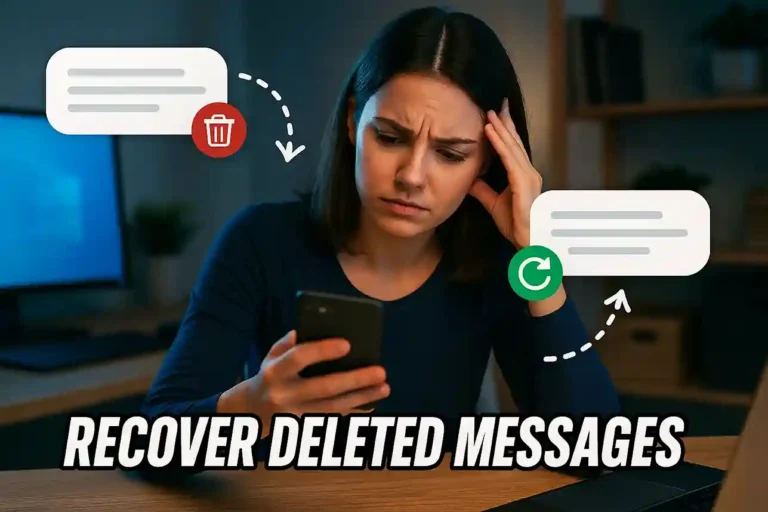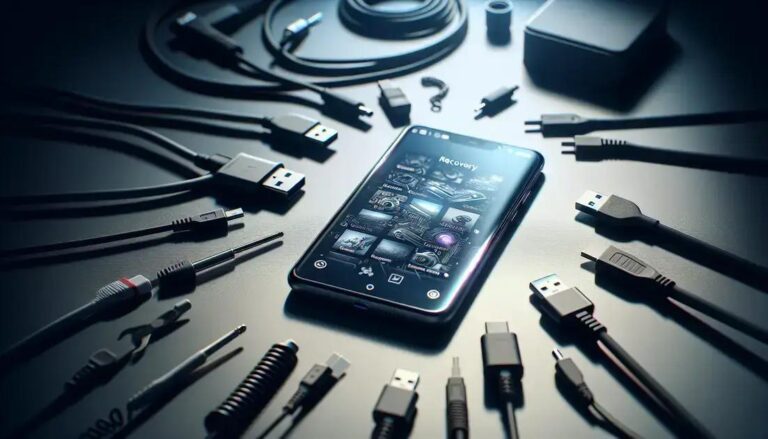How to Retrieve Deleted Text Messages: techniques that work
Learning how to retrieve deleted text messages opens doors to recovering precious memories and vital data.
Discover proven methods that restore your lost conversations without requiring advanced technical knowledge today.
Start exploring these reliable recovery solutions and regain access to your important messaging history right now.
Understanding Text Message Recovery Basics
Text messages contain valuable personal and business information that users often delete accidentally or lose during device malfunctions.
Modern smartphones store messaging data in multiple locations, creating opportunities to recover phone messages through various technical approaches.
Understanding these storage methods helps users choose the most effective recovery technique for their specific situation and device type.
Most mobile devices automatically create temporary backup files that preserve deleted content for limited periods before permanent removal.
Recovery success depends heavily on timing, as overwriting occurs when new data replaces deleted message storage space on device memory.
Professional recovery tools can access these hidden storage areas where restore deleted SMS data remains temporarily available for extraction.
Android Message Recovery Methods
Android devices offer multiple pathways to retrieve messages on Android through built-in features and third-party applications designed for data recovery.
Google automatically backs up messaging data to cloud storage when users enable automatic backup features in their device settings menu.
This backup system preserves conversations and allows users to restore deleted conversations after factory resets or device transfers seamlessly.
Using Google Drive Backup
Google Drive serves as the primary backup location for Android messaging data when users activate automatic backup functionality.
Users can access their backup files by navigating to Google Drive settings and locating the device backup section containing messaging data.
Restoration requires downloading backup files and following guided prompts to get back lost texts from previous backup dates available.
Third-Party Recovery Applications
Specialized message recovery app solutions scan device storage for deleted messaging data that remains recoverable through advanced algorithms.
These applications work by analyzing storage sectors where deleted messages resided before being overwritten by new device data.
Popular recovery tools include Dr.Fone, DiskDigger, and GT Recovery, each offering unique features for comprehensive SMS backup restore operations.
iPhone Text Message Recovery Solutions
iPhone users benefit from Apple’s integrated backup systems that automatically preserve messaging data through iCloud and iTunes backup protocols.
iCloud backup occurs automatically when devices connect to WiFi networks, ensuring recent messaging history remains accessible for recovery purposes.
iTunes backup creates local computer storage copies that contain complete messaging databases for comprehensive restore deleted conversations procedures.
Apple’s backup system preserves complete conversation threads, including multimedia attachments and timestamp information for accurate restoration.
Users can access backup options through Settings, Apple ID, iCloud, and iCloud Backup to verify automatic backup activation status.
Recovery requires restoring entire device backup files, which replaces current data with backup content from selected restoration dates.
iCloud Backup Restoration
iCloud backup restoration involves erasing current device content and replacing it with previously saved backup data containing deleted messages.
This process requires users to reset their device completely and select backup restoration during the initial setup process.
Restoration includes all backup content, not just messaging data, making it suitable for complete device recovery situations only.
iTunes Local Backup Recovery
iTunes creates detailed local backup files on computers that contain comprehensive messaging databases with all conversation history.
Users can restore specific backup dates by connecting devices to computers and selecting desired backup files through iTunes interface.
This method preserves more detailed data than iCloud backup and offers greater control over restoration timing and content.
Professional Text Message Recovery Tools
Professional text message recovery tool solutions provide advanced capabilities for recovering mobile texts from severely damaged or corrupted devices.
These specialized applications use forensic-level scanning techniques to locate and extract messaging data from device storage systems.
Professional tools often succeed where basic recovery methods fail, especially in cases involving hardware damage or extensive data corruption.
Leading professional recovery applications include:
- PhoneRescue for comprehensive iOS and Android recovery
- 3uTools for iPhone-specific messaging restoration
- Wondershare Dr.Fone for cross-platform recovery solutions
- Tenorshare UltData for advanced recovery algorithms
- iMobie AnyTrans for backup management and recovery
These tools typically require computer installation and device connection through USB cables for direct storage access and scanning.
Success rates vary depending on device condition, deletion timeframe, and amount of new data written since message deletion occurred.
Choosing the Right Recovery Tool
Selecting appropriate recovery software depends on device type, operating system version, and specific recovery requirements for individual situations.
Free recovery tools offer basic scanning capabilities, while premium versions provide advanced features like selective recovery and preview options.
Users should research tool compatibility with their specific device models before purchasing premium recovery software for optimal results.
Carrier-Based Message Recovery Options
Mobile carriers maintain temporary records of text messaging traffic that may include deleted message content for legal and billing purposes.
Carrier recovery options vary significantly between service providers, with some offering customer access to messaging logs upon request.
Legal requirements and privacy policies govern carrier data retention, limiting public access to stored messaging information in most cases.
Major carriers like Verizon, AT&T, and T-Mobile maintain different policies regarding customer access to deleted messaging records.
Requesting carrier assistance typically requires account verification and may involve fees for data retrieval services when available to customers.
Business accounts often receive priority access to carrier-stored messaging data due to compliance and legal documentation requirements.
Contacting Your Carrier
Customer service representatives can provide information about available message recovery services and associated costs for data retrieval.
Account holders must verify identity through security questions and account information before accessing any stored messaging data.
Carriers may require written requests or legal documentation for accessing deleted messaging records depending on company policies.
Preventing Future Message Loss
Implementing preventive measures ensures that users can easily retrieve messages from backup systems when accidental deletion occurs in future.
Regular backup scheduling creates multiple recovery points that preserve messaging history across different time periods for comprehensive protection.
Cloud storage integration provides automatic backup functionality that operates transparently without requiring manual intervention from device users.
Recommended backup strategies include:
- Enabling automatic cloud backup for continuous protection
- Creating weekly manual backup files on external storage
- Using third-party backup applications for additional security
- Exporting important conversations to email or document files
Multiple backup methods provide redundancy that increases recovery success rates when primary backup systems fail or become corrupted.
Regular backup verification ensures that backup systems function correctly and contain accessible messaging data for future recovery needs.
Setting Up Automatic Backups
Automatic backup configuration varies between Android and iPhone devices, requiring different setup procedures for optimal messaging protection.
Android users can enable Google backup through Settings, System, Backup, and activating SMS backup functionality for comprehensive protection.
iPhone users should verify iCloud backup activation through Settings, Apple ID, iCloud, and ensuring Messages backup remains enabled.
Advanced Recovery Techniques
Advanced recovery methods involve technical procedures that access low-level device storage where deleted SMS on phone data persists temporarily.
Root access on Android devices enables advanced recovery applications to scan protected storage areas containing deleted messaging databases.
These techniques require technical expertise and may void device warranties, making them suitable only for experienced users or professionals.
Computer forensics techniques can recover mobile texts from device memory chips even after standard deletion and factory reset procedures.
Professional data recovery services offer laboratory-level recovery capabilities for devices with hardware damage or extensive data corruption issues.
Advanced techniques often succeed in recovering messaging history that standard recovery methods cannot access through normal device interfaces.
Root Access Recovery
Android device rooting provides administrative access to system files containing deleted messaging databases and temporary storage areas.
Rooted devices can utilize specialized recovery applications that scan protected storage partitions for recoverable messaging data fragments.
This method requires technical knowledge and carries risks including device damage and warranty voiding for inexperienced users.
Professional Data Recovery Services
Professional recovery services employ specialized equipment and techniques to retrieve messaging data from severely damaged or corrupted devices.
These services can recover data from devices with physical damage, water damage, or complete system failures affecting normal operation.
Costs for professional recovery range from hundreds to thousands of dollars depending on device condition and recovery complexity.
Troubleshooting Common Recovery Issues
Recovery attempts may fail due to various technical issues including corrupted backup files, outdated recovery software, or device compatibility problems.
Understanding common failure points helps users identify alternative recovery methods when initial attempts to android message restore fail completely.
Systematic troubleshooting approaches increase success rates by addressing technical obstacles that prevent successful message recovery operations.
Common recovery obstacles include:
- Insufficient storage space for backup restoration
- Corrupted backup files with incomplete data
- Outdated recovery software lacking device support
- Operating system updates that change storage formats
- Hardware damage affecting data access capabilities
Resolving these issues often requires updating software, freeing storage space, or attempting recovery using alternative methods and tools.
Multiple recovery attempts using different techniques increase overall success rates when individual methods fail to recover texting history completely.
Backup File Corruption
Corrupted backup files result from interrupted backup processes, storage device failures, or software conflicts during backup creation procedures.
Users can attempt backup repair using specialized tools or create new backup files from remaining device data sources.
Alternative backup sources like cloud storage or computer backups may contain intact messaging data when primary backups fail.
Legal and Privacy Considerations
Message recovery activities must comply with legal requirements and privacy regulations governing personal data access and retrieval procedures.
Users should only attempt to restore lost message threads from devices they legally own or have explicit permission to access.
Corporate and business environments require additional legal considerations when recovering messaging data from company-owned devices and accounts.
Privacy laws vary by jurisdiction and may restrict access to messaging data stored by carriers or third-party service providers.
Legal consultation may be necessary for recovery situations involving legal proceedings, custody disputes, or business compliance requirements.
Ethical recovery practices respect privacy rights while pursuing legitimate data recovery objectives for personal or business purposes.
Conclusion
Understanding how to retrieve deleted text messages empowers users to recover valuable communication data through multiple proven techniques and approaches.
Success depends on acting quickly, choosing appropriate recovery methods, and implementing preventive backup strategies for future protection against data loss.
Regular backup maintenance and familiarity with recovery options provide the best foundation for successful mobile text recovery when deletion occurs.
Frequently Asked Questions
Can I recover deleted text messages without a backup?
Yes, specialized recovery applications can scan device storage for deleted messaging data that remains temporarily recoverable before overwriting.
How long do deleted messages remain recoverable?
Recovery timeframes vary from hours to weeks depending on device usage, available storage space, and new data creation after deletion.
Do carriers keep copies of deleted text messages?
Carriers maintain temporary messaging records for billing purposes, but customer access varies significantly between different service providers and account types.
Is it possible to recover messages from a factory reset phone?
Factory reset recovery requires previous backup files or professional data recovery services using specialized equipment and forensic techniques.
Are free message recovery apps effective?
Free recovery applications offer basic scanning capabilities with limited success rates compared to premium tools with advanced recovery algorithms.






